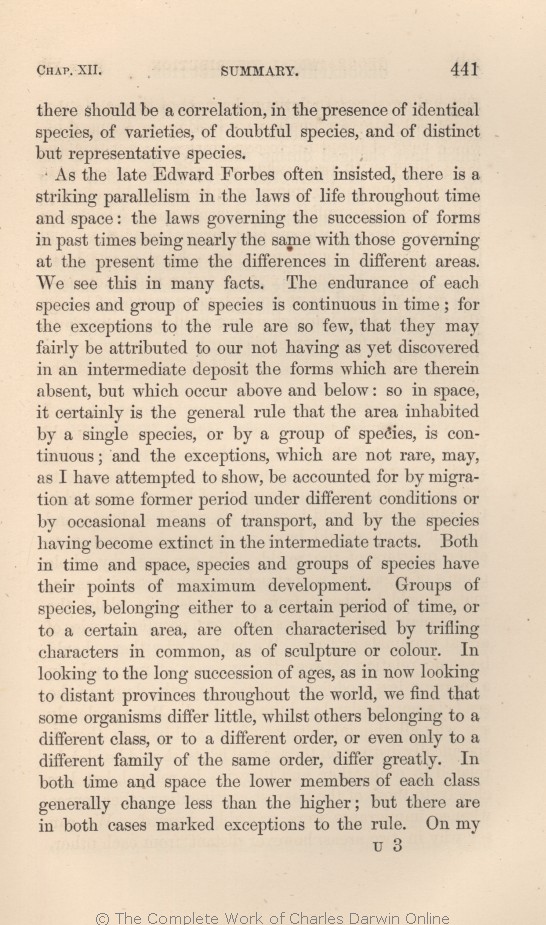there should be a correlation, in the presence of | there should be a correlation, in the presence of 1859 1860 1861 1866 |
| where very closely allied or representative species exist, there should almost always exist some 1869 |
| some 1872 |
| species, 1859 1860 1861 1866 | | species. 1869 | | species 1872 |
| of varieties, of doubtful species, and of distinct but representative species. 1859 1860 1861 1866 |
| will almost always there be found. 1872 |
| OMIT 1869 |
|
As the late Edward Forbes often insisted, there is a striking parallelism in the laws of life throughout time and
space: | space: 1859 1860 1861 1866 1869 | | space; 1872 |
| exceptions 1859 1860 1861 1866 1869 | | apparent exceptions 1872 |
| the 1859 1860 1861 1866 | | certain 1869 1872 |
| therein 1859 1860 1861 1866 | therein 1869 1872 |
| absent, 1859 1860 1861 1866 | | absent 1869 1872 |
| but 1859 1860 1861 1866 |
| in it, but 1869 1872 |
| above 1859 1860 1861 | | both above 1866 1869 1872 |
| continuous; 1859 1860 1861 1866 | | continuous, 1869 1872 |
| migration at some former period 1859 1860 1861 |
| former migrations 1866 1869 1872 |
| conditions 1859 1860 1861 1866 | | circumstances, 1869 1872 |
| by 1859 1860 1861 | | through 1866 1869 1872 |
| and 1859 1860 1861 | | or 1866 1869 1872 |
| belonging either to a certain 1859 1860 1861 |
| living during the same 1866 1869 1872 |
| to a certain 1859 1860 1861 |
| living within the same 1866 1869 1872 |
| characters 1859 1860 1861 | | features 1866 1869 1872 |
| ages, 1859 1860 1861 | | past ages, 1866 1869 1872 |
| now 1859 1860 1861 1866 1869 | now 1872 |
| some organisms 1859 1860 1861 |
| certain organisms 1866 |
| species in certain classes 1869 1872 |
| little, 1859 1860 1861 | | little 1866 1869 1872 |
| whilst others belonging to a different 1859 1860 1861 |
| from each other, whilst others belonging to a different 1866 |
| from each other, whilst others in a different 1869 |
| from each other, whilst those in another 1872 |
| to 1859 1860 1861 1866 | | only in 1869 1872 |
| order, or even only to a different family 1859 1860 1861 |
| order, or only to a different family 1866 |
| family 1869 |
| section 1872 |
| greatly. 1859 1860 1861 |
| greatly from each other. 1866 1869 1872 |
| lower 1859 1860 1861 | | lowly organised 1866 1869 1872 |
| higher; 1859 1860 1861 | | highly organised; 1866 1869 1872 |
| On my 1859 1860 1861 1866 |
| According to our 1869 1872 |
|









